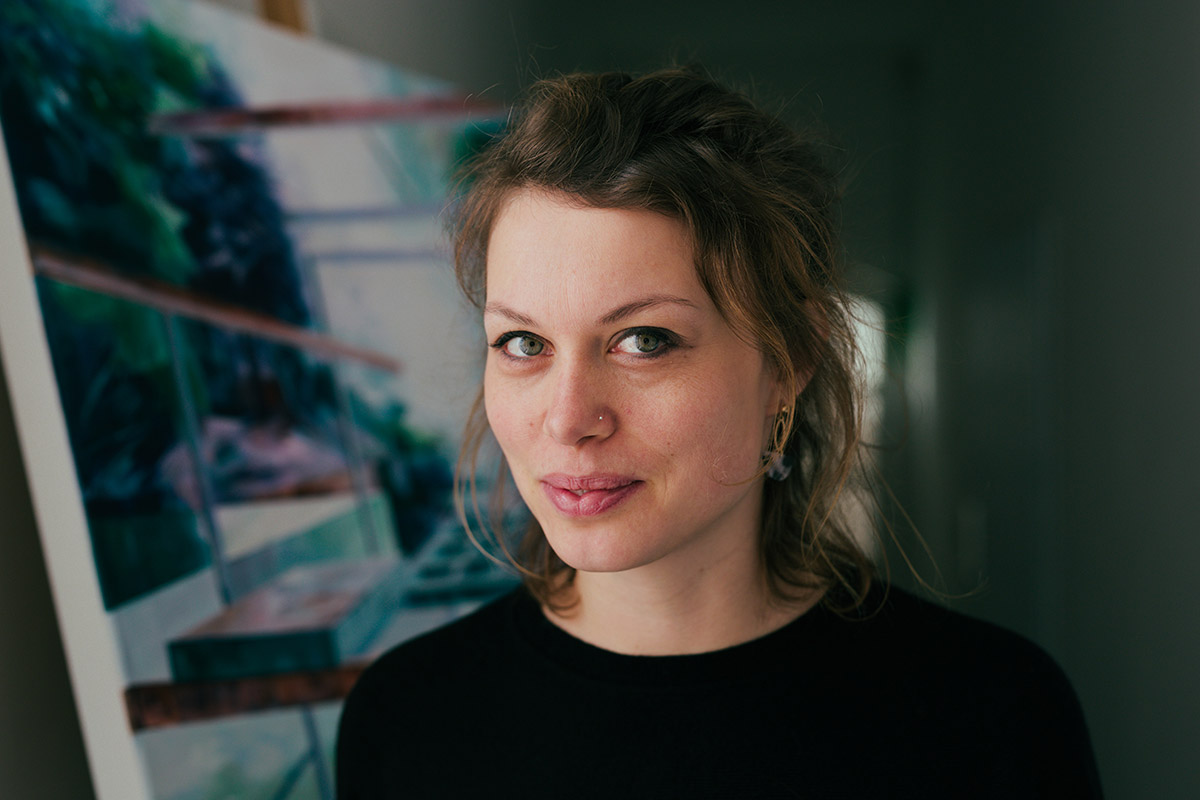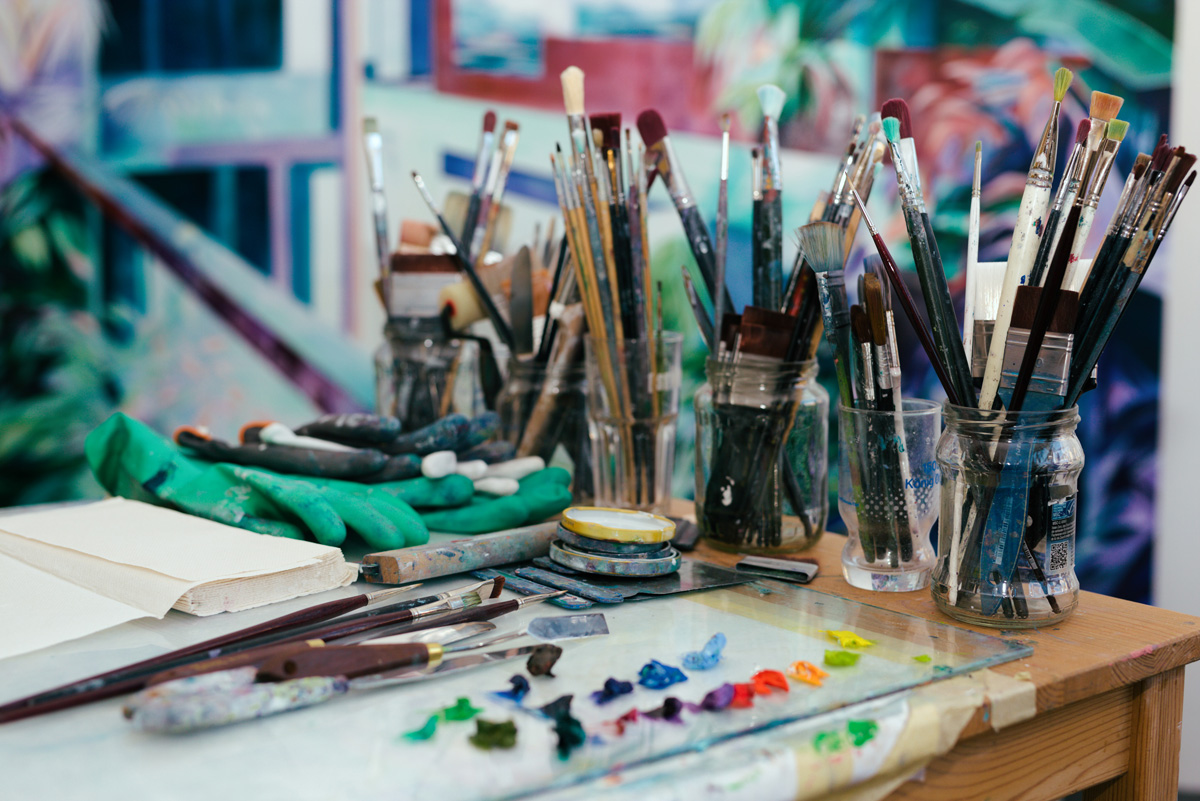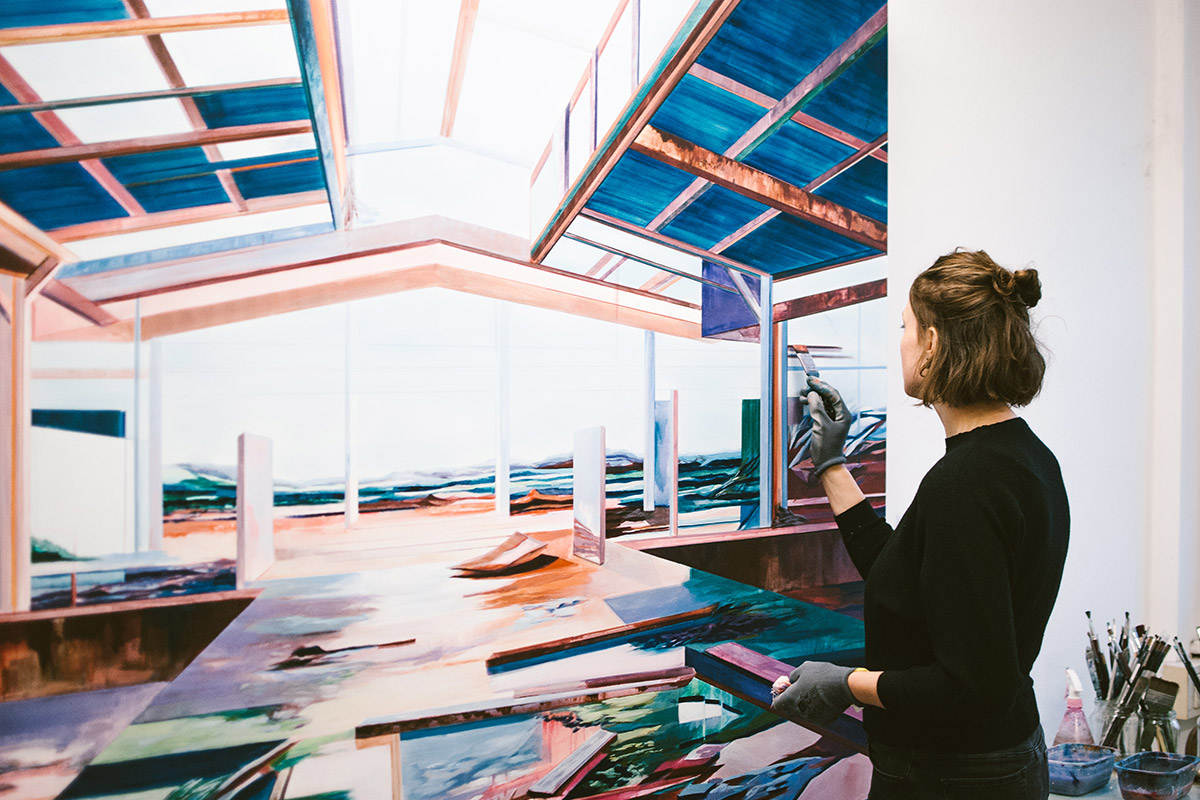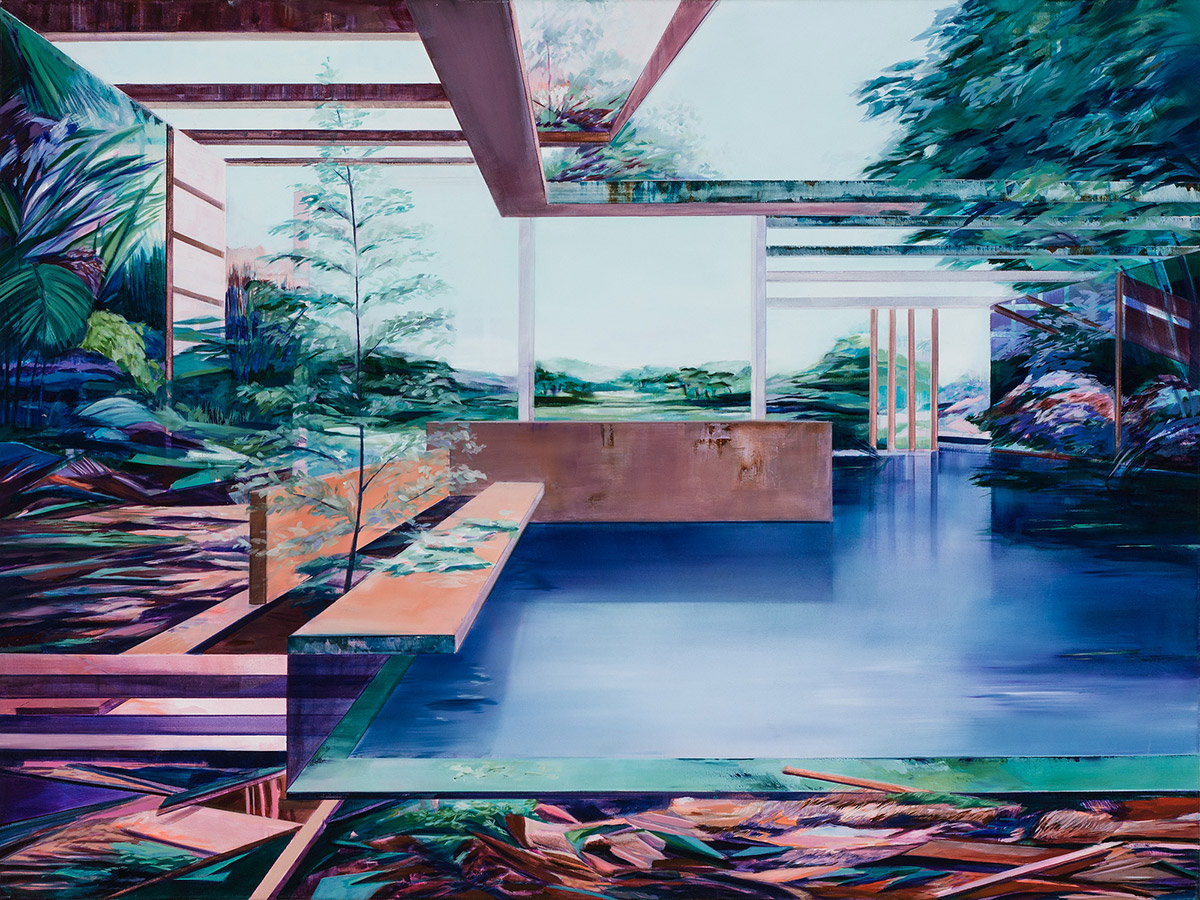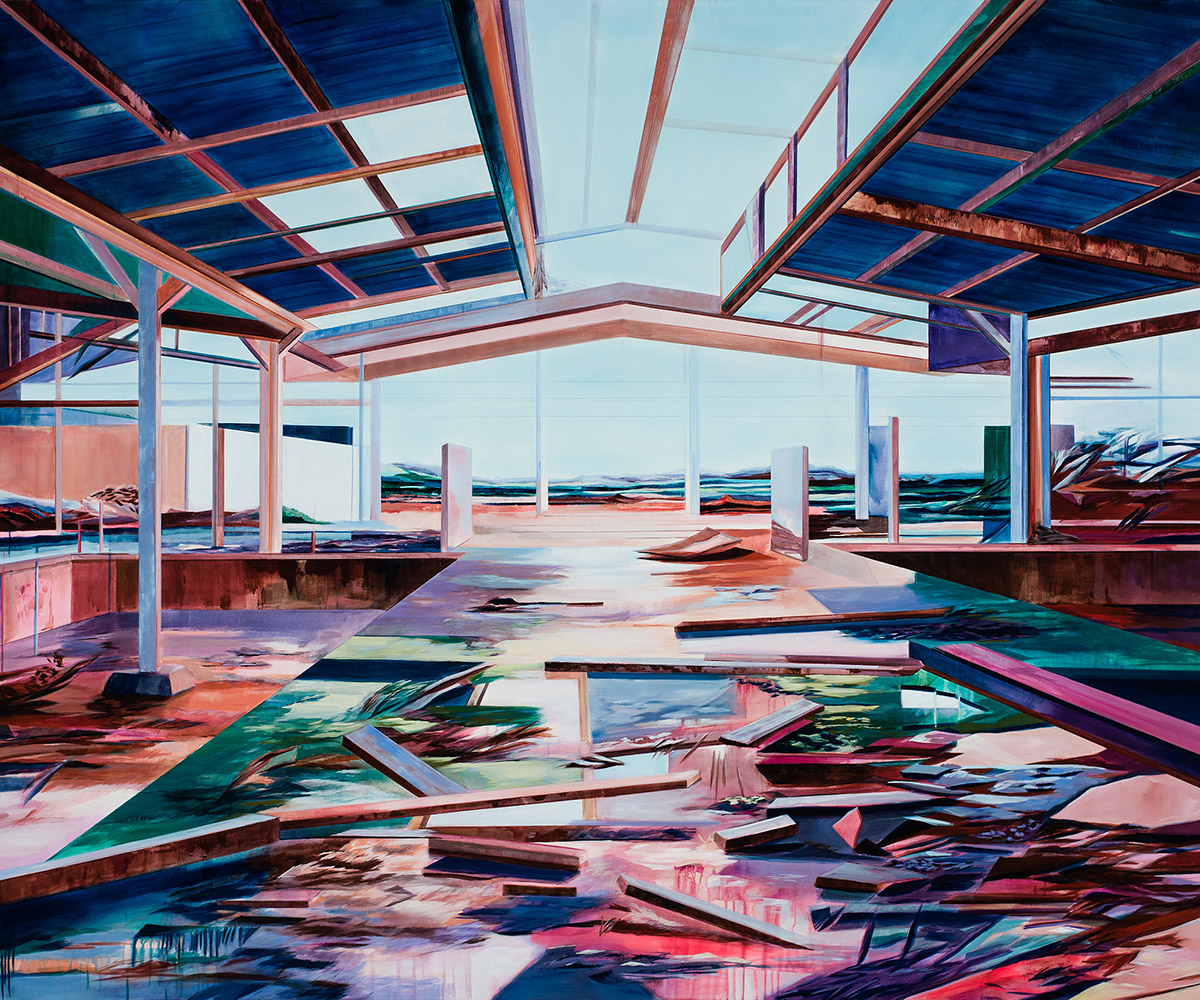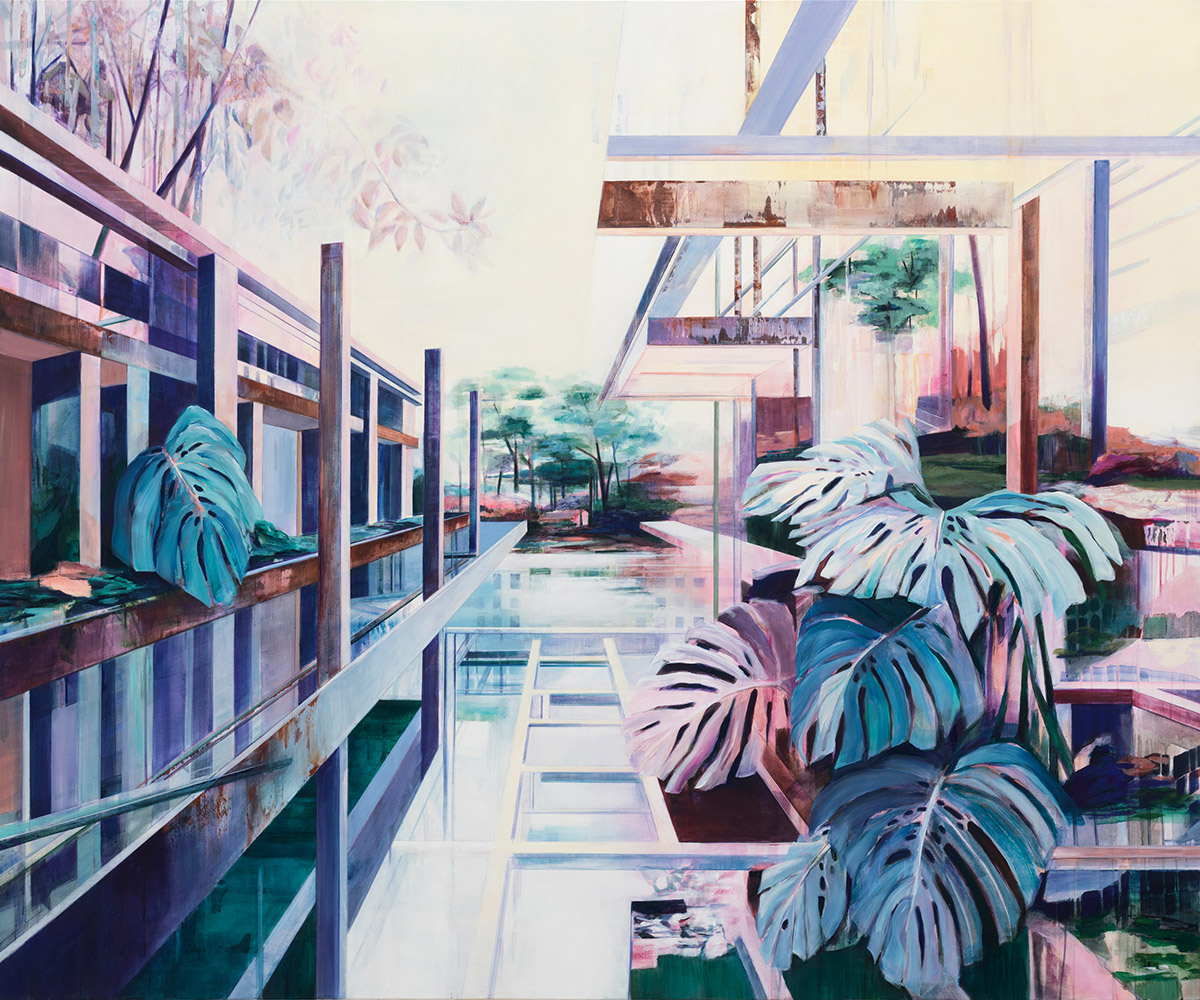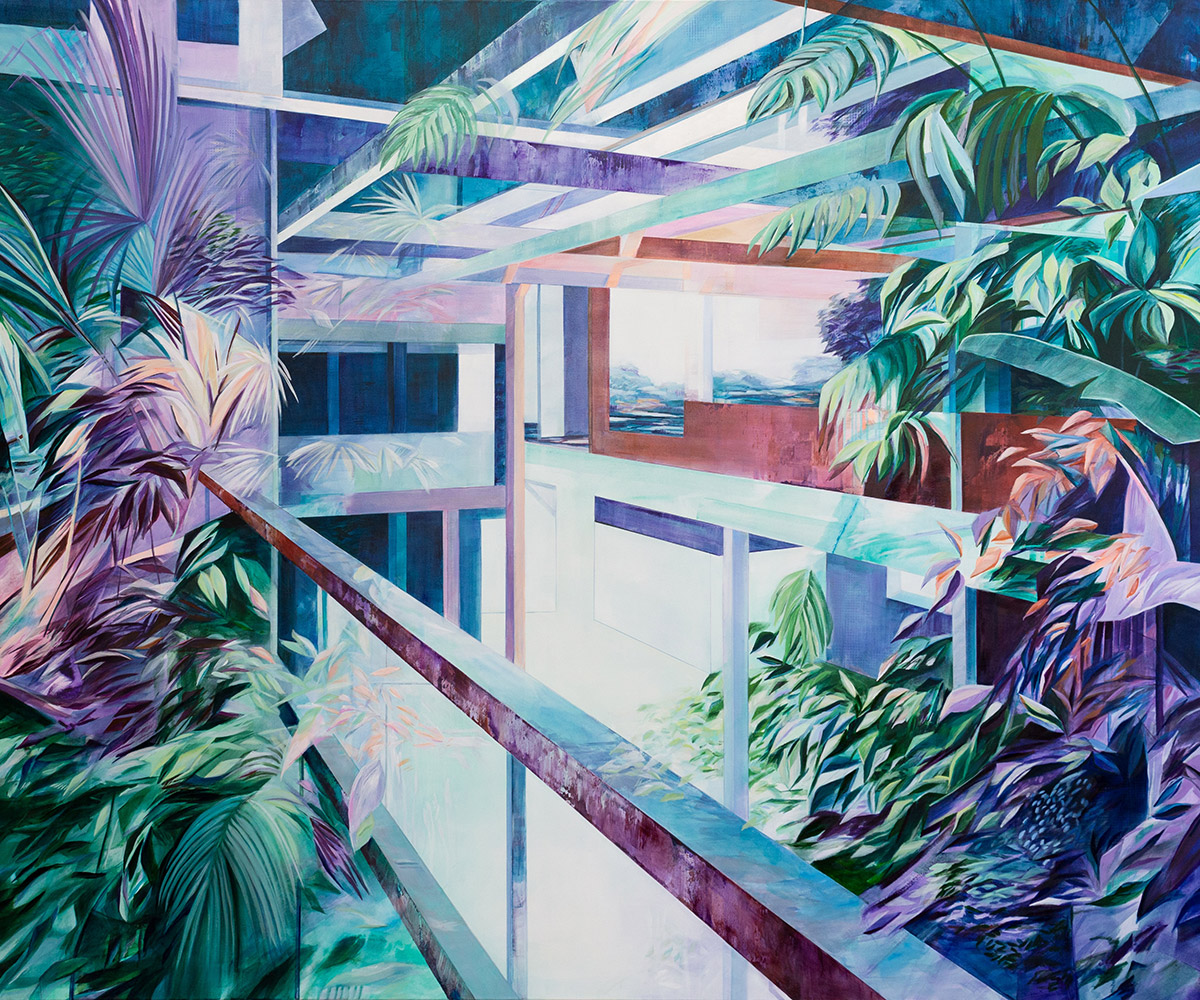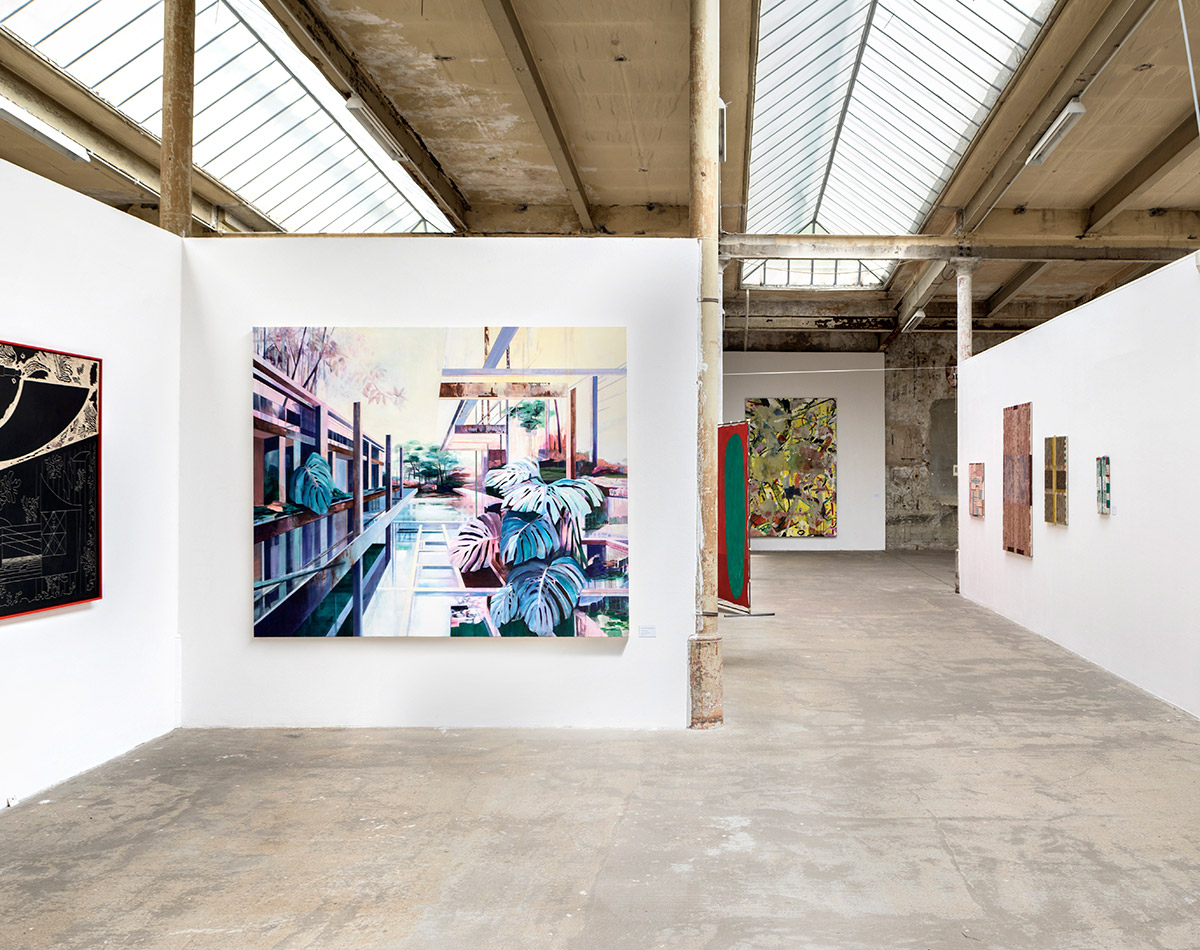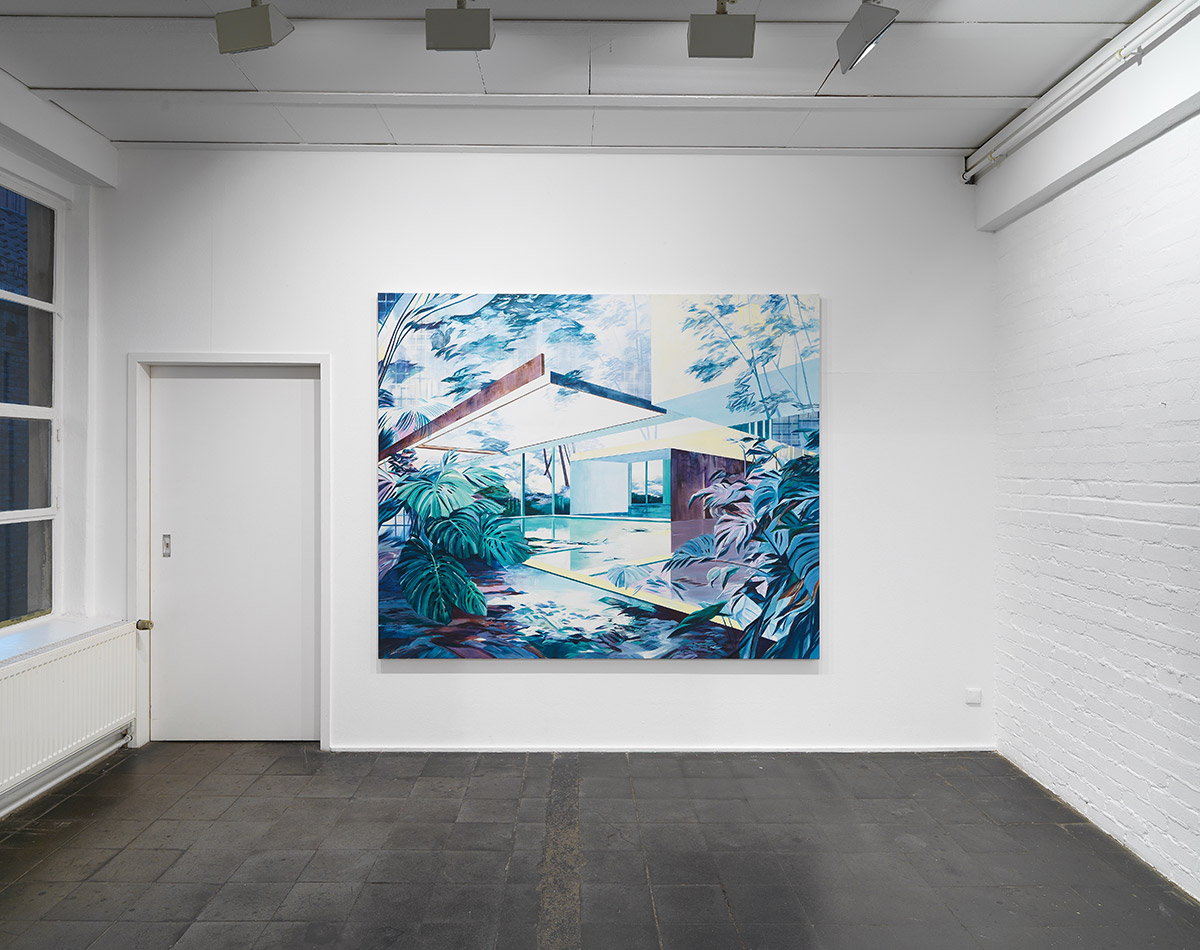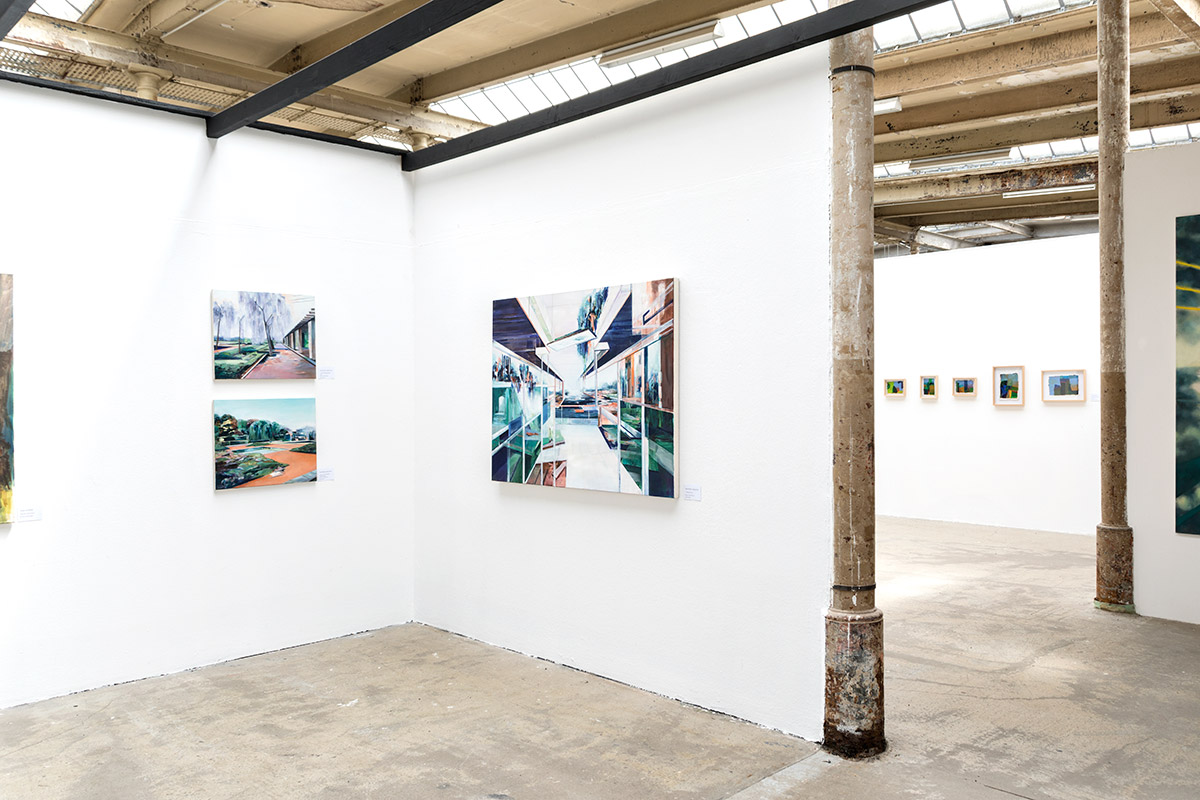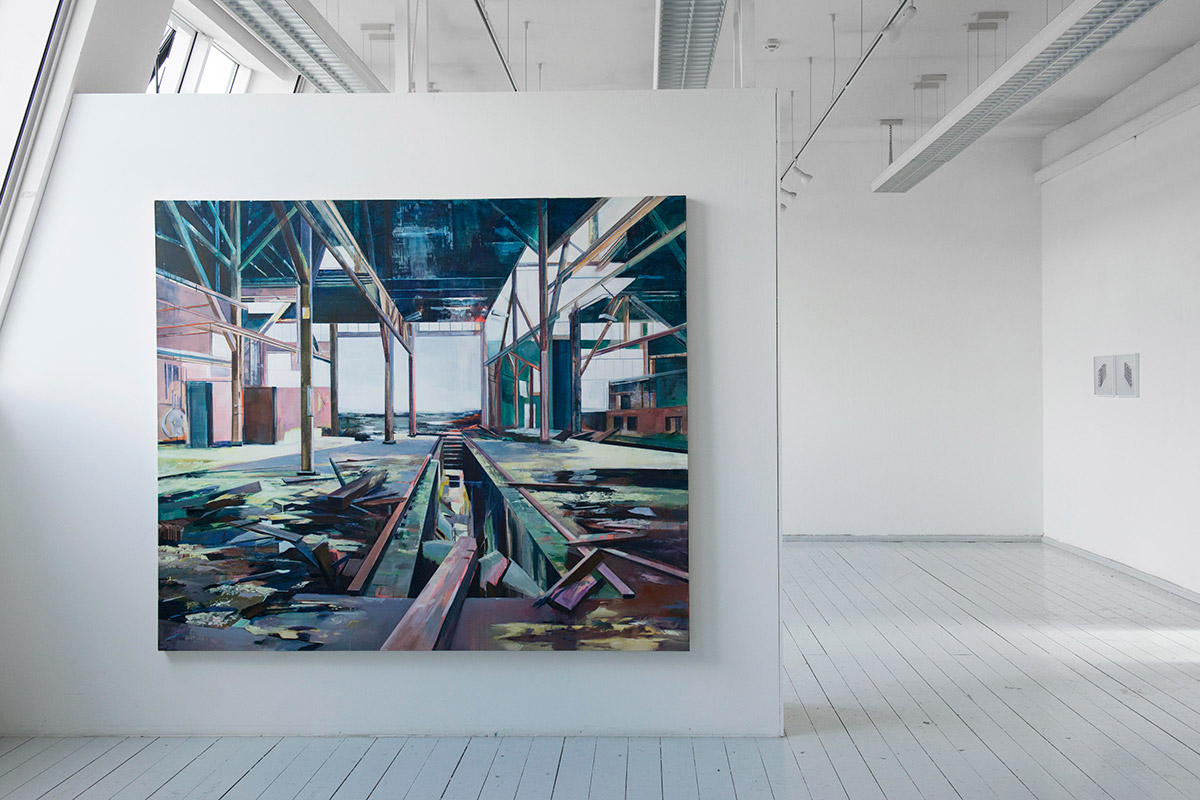22/003
Dorothee Liebscher
Painter
Leipzig
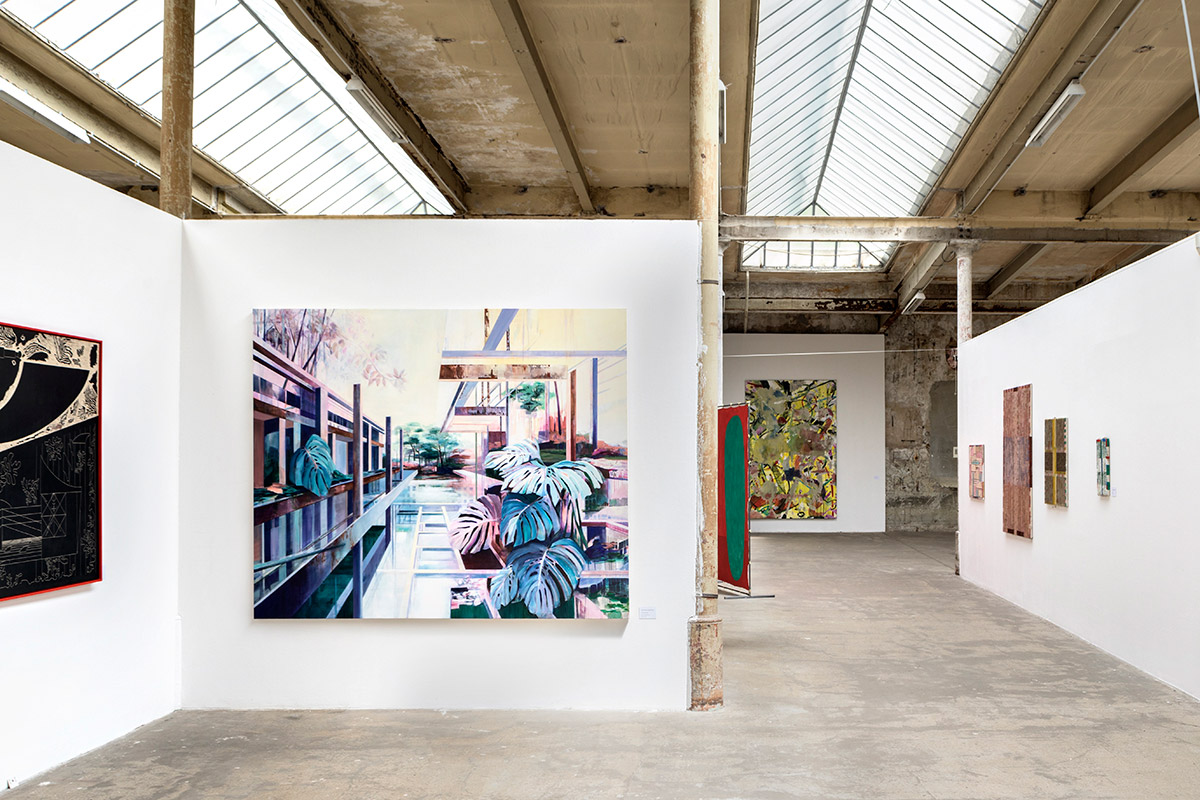
«My paintings are an invitation to a journey through utopian landscapes.»
«My paintings are an invitation to a journey through utopian landscapes.»
«My paintings are an invitation to a journey through utopian landscapes.»
«My paintings are an invitation to a journey through utopian landscapes.»
«My paintings are an invitation to a journey through utopian landscapes.»
Please, introduce yourself…
Hi! My name is Dorothee Liebscher. I am a painter and I live and work in Leipzig. I studied painting and graphic arts at the Academy of Fine Arts in Leipzig (HGB) between 2014 and 2019. Since then I have been working as a freelance painter.
In painting I am particularly interested thematically in the interplay between architecture and nature. I can compose the forms quite freely, create imaginary spaces and immerse them through the special play of colors in a very unique poetic-fantastic atmosphere.
Portrait – Dorothee Liebscher – © Clemens Jurk
Portrait – Dorothee Liebscher – © Clemens Jurk
How did you find your way into the field of art and architecture?
Painting allows me to express myself freely, without any limits. I always liked this and so I developed the dream of studying painting. But I only could fulfil that dream after starting with my first degree in teaching (teaching special education / art).
The theme of architecture in painting had its initial spark on me during a trip in Porto. I was fascinated by the abandoned houses, of which only an outer facade and the interior ceiling construction of the beams remained. These abandoned premises I wanted to depict necessarily, but in a very unique way. Thus, the first large formats were created and since then the theme of architecture in painting has not let me go.
What comes to your mind, when you think about your time at HGB Leipzig? How did you experience the transition after graduation?
My time at the HGB was characterized by a lot of freedom in what you do. For a few years, I did it as a parallel course to my teaching degree. That was quite stressful, but in the end I was happy to have completed both degrees and to have gotten to know both worlds. Often I could only spent the evenings in the studio and painted all night long. Fortunately, the night guard at the university never locked me out. Overall, I really enjoyed my time at the HGB, I was able to make contacts and develop artistically.
The leap into self-employment went smoothly for me, I immediately had numerous exhibitions, and so my self-confidence grew that I can manage being a free artist without the shelter of the academy. I was lucky enough to be represented by a gallery during my studies, so everything could grow slowly.
How would you characterize Leipzig as location for working as an artist? How is the context of this place influencing your work?
Leipzig is formative for my work in many ways. On the one hand, it is a city full of cultural and creative offerings. The input through numerous exhibitions but also the contacts are very important for me and my artistic work.
On the other hand, the changing cityscape shapes my subject matter in painting. As my paintings are mainly deserted, abandoned spaces that are reclaimed by nature. Many impressions for the paintings come from the immediate surroundings; from brownfields that I have seen in and around Leipzig. Leipzig is currently undergoing a rapid process of change – many previously wildly overgrown corners and open spaces are being built on, many things are being redeveloped. It is not least an examination of this process of upheaval, the role of nature in the city and the intervention of man, also with regard to very modern, current buildings. Who was there first and what will become of today's architecture if it is left behind and abandoned to nature?
What does your desk/working space look like?
A picture of my workspace when I have tidied up. During the painting process, the paint is of course wildly distributed on the palette, but I like to start the next day at a tidy workplace.
My studio is in a large studio house in Leipzig West. The district changed dramatically in recent years. There are now numerous bars and restaurants in front of my studio, so there's definitely always something going on. Nevertheless, the space is a good retreat for creativity.
How changed corona the way you work?
The lockdown allowed me to slow down, and I was able to concentrate very well on painting. It was good to be able to lose myself in the matter without having to urgently finish something because the next exhibition or trade fair was already around the corner. Nevertheless, it was of course frustrating that so many planned events were canceled, and I hope that the lockdown will not happen again next winter, but that everything will slowly move towards normality.
For you personally, what is the essence of architecture?
I think it's incredibly exciting that every building is linked to its very own history and that many people have lived and worked in these rooms before my time. This becomes particularly clear when traces from way back come to light. For me, architecture is also a mirror of the spirit of the times. It sometimes shows the achievements of a society, but nothing is eternal. As massive as buildings seem, they can also be fragile. Architecture is a source of inspiration for me, from which I can draw for painting.
How would you describe the relationship between Art and Architecture?
Architecture can also become a work of art itself. I am impressed when a very individual atmosphere is created and forms are played with in an artfully aesthetic way.
In the old factory buildings in Leipzig, for example, you can see how the architectural construction goes beyond functionality. At that moment, something was created that obeyed other standards than rational or economic implementation. Aesthetic standards were applied. Just like painting, a room or a building can create an atmosphere, a mood.
When artwork hangs in a room, it also creates an interesting interaction with that environment. It is very important where the art is exhibited. Not every place is suitable for it, in my opinion.
How do you communicate Space?
In painting I can create spatial illusions that do not occur in reality. Through construction and deconstruction, surreal landscapes with architectural structures arise, which often can not be classified temporally and spatially. I am particularly interested in the architectural distortions and fractures, which the viewer may notice only at second glance.
My intention is that the viewer, as a figure, enters the picture himself and can walk through it with his gaze. Through the ambivalence of reality and fiction, one can always discover something new in the pictures.
My paintings are an invitation to a journey through utopian landscapes, a kind of parallel world, which break up the logical spatial dimensions as well as question the function of architecture and nature. I process on the canvas impressions that surround me and transform them into a certain hyperreality. Dilapidated industrial wastelands in Leipzig and the surrounding area played a major role in my paintings for a long time. More and more I am now interested in the modern architectural experiments in my environment and the function of nature in the urban cityscape. These two themes currently merge with each other and penetrate each other.
People are not supposed to find their way around in these imaginary, nested spaces, they are not supposed to know whether the planks hold, the floor is walkable, the rails follow their original purpose or are just a decorative ornament in a constructed overall picture. Even if the constructions seem to be real, they completely originate from a different inner logic and only point to the otherwise essential construction elements that are figuratively familiar to us.
What needs to change in the fields of art and architecture according to you?
In terms of architecture, I see a lot of new buildings that purport to have a certain minimalism, but the real reason for the construction method is just to reduce costs. I think there is often no sustainable thinking. What will the buildings look like in 100 years? Will only fragments of the actual architecture still be visible, as in my paintings? Furthermore, in my opinion, greening in urban space is often not given enough space. Nature is often seen only as an accessory, but plays such an important role in our lives and for the future, even in the city. My pictures could give an impetus to think about exactly these issues.
Project
Works
Leipzig
2019 – 2021
Paintings
In spatial Context
Painting I: Panorama | 105 × 140 cm | Acrylic and Oil on Canvas | © Thomas Raatz
Painting II: Glühen | 75 × 100 cm | Acrylic and Oil on Canvas | © Thomas Raatz
Painting III: Durchfahrt | 190 × 230 cm | Acrylic and Oil on Canvas | © Thomas Raatz
Painting IV: Fensterblatt | 190 × 230 cm | Acrylic and Oil on Canvas | © Julius Schreiner
Painting V: Symbiose | 190 × 230 cm | Acrylic and Oil on Canvas | © Clemens Jurk
Painting VI: Lichtspiel | 190 × 230 cm | Acrylic and Oil on Canvas | © Thomas Raatz
Exhibition I; Fensterblatt | Werkschauhalle | © Julius Schreiner
Exhibition II; Lichtspiel | Galerie Robert Drees | © Roland Schmidt
Exhibition III; Wasserhaus | Werkschauhalle | © Julius Schreiner
Exhibition IV; Haltepunkt | HGB | © Bastian Gehbauer
Painting I: Panorama | 105 × 140 cm | Acrylic and Oil on Canvas | © Thomas Raatz
Painting II: Glühen | 75 × 100 cm | Acrylic and Oil on Canvas | © Thomas Raatz
Painting III: Durchfahrt | 190 × 230 cm | Acrylic and Oil on Canvas | © Thomas Raatz
Painting IV: Fensterblatt | 190 × 230 cm | Acrylic and Oil on Canvas | © J. Schreiner
Painting V: Symbiose | 190 × 230 cm | Acrylic and Oil on Canvas | © Clemens Jurk
Painting VI: Lichtspiel | 190 × 230 cm | Acrylic and Oil on Canvas | © Thomas Raatz
Exhibition I; Fensterblatt | Werkschauhalle | © Julius Schreiner
Exhibition II; Lichtspiel | Galerie Robert Drees | © Roland Schmidt
Exhibition III; Wasserhaus | Werkschauhalle | © Julius Schreiner
Exhibition IV; Haltepunkt | HGB | © Bastian Gehbauer
